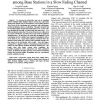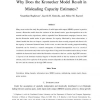33 search results - page 5 / 7 » Modeling and Capacity of Polarized MIMO Channels |
TWC
2010
12 years 12 months ago
2010
We develop a realistic model for multiple-input multiple-output (MIMO) broadcast channels, where each randomly located user's average SNR depends on its distance from the tran...
ICC
2007
IEEE
13 years 9 months ago
2007
IEEE
To increase the achievable sum rate of downlink MIMO (Multiple Input Multiple Output) systems, the cooperation among Base Stations (BS) is investigated in a slow fading channel. Th...
TIT
2010
13 years 12 hour ago
2010
Many recent works that study the performance of multi-input multi-output (MIMO) systems in practice assume a Kronecker model where the variances of the channel entries, upon decom...
CISS
2011
IEEE
12 years 9 months ago
2011
IEEE
—Mobile optical wireless has so far been limited to very short ranges for high data rate systems. It may be feasible to overcome the data rate limitations over large transmission...
CORR
2006
Springer
13 years 5 months ago
2006
Springer
We consider transmission over the ergodic fading multiple-antenna broadcast (MIMO-BC) channel with partial channel state information at the transmitter and full information at the ...


